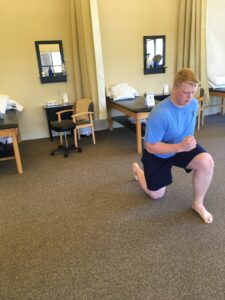Hockey great Brendan Shanahan once responded this way to the question, “Is hockey hard?”
“Is hockey hard? I don’t know, you tell me. We need to have the strength and power of a football player, the stamina of a marathon runner, and the concentration of a brain surgeon. But we need to put all this together while moving at high speeds on a cold and slippery surface while 5 other guys use clubs to try and kill us. Oh yeah, did I mention that this whole time we’re standing on blades 1/8 of an inch thick? Is ice hockey hard? I don’t know, you tell me. Next question.”
When you put it that way, hockey sounds like it would be a tough sport to stay healthy. Even though preventing injury in hockey is complex and not always possible, strengthening key muscle groups and joint areas can help keep you on the ice. Here are key areas to train to stay healthy:
Knee and Hip Strength
Obviously, training legs for hockey is huge, but making sure the muscles around the hip and knee are strong can help reduce the likelihood of injuries to the ACL, MCL, and other soft tissue.
Exercises you can do to improve knee and hip strength:
Lunge Series– A combination of forward, side, and backward lunges, making sure the knee does not go past the toe when going into the lunge.


Bavarian Split Squat– A more advanced exercise where the back foot rests on an elevated bench while in a lunge position, making sure the forward knee does not go over the toe when going into the squat. Weight can be added to this exercise when the form is mastered.

Core Strength
In hockey, all power and physical ability stems from the lower body and core. Not only will strengthening the core improve attributes like shot power and skating ability, it will help your body react to twisting, pulling, and getting hit so as to prevent injury in these circumstances.
Exercises to improve core strength:
Plank Series–
Traditional Plank– body propped on elbows in pushup position creating tension from head to toe.

Side Plank– body propped on one elbow with the other arm in the air or on the hip.

Side Plank with Reach– start in side plank, reach underneath the stabilizing arm in the armpit area.


Russian Twist– With feet crossed and off the ground, hips and knees bent, back off the ground balancing on the buttock, twist from side to side touching both hands to the ground on each side of the body. A medicine ball or weight can be added to increase difficulty.

Agility
Agility is the ability to move and change directions quickly. Hockey players train agility to improve skating performance but will also benefit from training joints to withstand the grind of playing hockey.
Exercises to improve agility:
Bounding- jumping from a one leg skating stance to another, pushing off with as much power as possible, and controlling the landing portion of each jump to increase stability of the hip, knee, and ankle.


Broad Jumps– jumping from a two legged stance with as much power as possible, and sticking the landing (Interesting note: Chicago Blackhawks Forward Jonathan Toews can broad jump 9’8”).

Ten Yard Sprint Out of Half Kneeling Stance– start facing sideways in a half kneel with the kneeling leg in the direction of the sprint. Push as hard as possible on the planted foot to start the sprint.

Train With A Program That Keeps Injury Prevention In Mind
Talk with a professional about providing in-season and off-season training programs to improve performance and keep your body healthy. In all sports, health is a skill that can be improved. For more information about injury prevention, training programs, and injury treatment, visit freedompt.com or call to make an appointment with one of our therapists who specialize in treating athletes from your sport!

